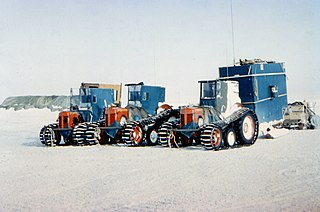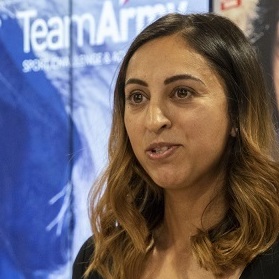Related Research Articles
Transport in Antarctica has transformed from explorers crossing the isolated remote area of Antarctica by foot to a more open era due to human technologies enabling more convenient and faster transport, predominantly by air and water, but also by land as well. Transportation technologies on a remote area like Antarctica need to be able to deal with extremely low temperatures and continuous winds to ensure the travelers' safety. Due to the fragility of the Antarctic environment, only a limited amount of transport movements can take place and sustainable transportation technologies have to be used to reduce the ecological footprint. The infrastructure of land, water and air transport needs to be safe and sustainable. Currently thousands of tourists and hundreds of scientists a year depend on the Antarctic transportation system.

The North Pole, also known as the Geographic North Pole, Terrestrial North Pole or 90th Parallel North, is the point in the Northern Hemisphere where the Earth's axis of rotation meets its surface. It is called the True North Pole to distinguish from the Magnetic North Pole.

The Commonwealth Trans-Antarctic Expedition (CTAE) of 1955–1958 was a Commonwealth-sponsored expedition that successfully completed the first overland crossing of Antarctica, via the South Pole. It was the first expedition to reach the South Pole overland for 46 years, preceded only by Amundsen's expedition and Scott's expedition in 1911 and 1912.

Snowkiting or kite skiing is an outdoor winter sport where people use kite power to glide on snow or ice. The skier uses a kite to give them power over large jumps. The sport is similar to water-based kiteboarding, but with the footwear used in snowboarding or skiing. The principles of using the kite are the same, but in different terrain. In the early days of snowkiting, foil kites were the most common type; nowadays many kiteboarders use inflatable kites. However, since 2013, newly developed racing foil kites seem to dominate speed races and expedition races, like Red Bull Ragnarok and the Vake mini-expedition race. Snowkiting differs from other alpine sports in that it is possible for the snowkiter to travel uphill and downhill with any wind direction. Like kiteboarding, snowkiting can be very hazardous and should be learned and practiced with care. Snowkiting has become more popular in places often associated with skiing and snowboarding, such as Russia, Canada, Iceland, France, Switzerland, Austria, Norway, Sweden, Finland and the Northern and Central United States. The sport has become more diverse as adventurers use kites to travel great distances and sports enthusiasts push the boundaries of freestyle, big air, speed and back country exploration.

Børge Ousland is a Norwegian polar explorer. He was the first person to cross Antarctica solo.
Andrew Regan is a British-born polar explorer and entrepreneur. He is the chief executive officer of Corvus Capital, an investment company.

Patriot Hills Base Camp was a private seasonally occupied camp in Antarctica. It was located in the Heritage Range of the Ellsworth Mountains, next to the Patriot Hills that gave it its name.
Hannah McKeand is an English polar explorer. In 2006 she set the record for the fastest journey to the South Pole a 600-nautical-mile (1,100 km) journey she completed solo and in just 39 days, 9 hours and 33 minutes. The record was broken in 2008 by Todd Carmichael of Spokane, Washington, United States. In March 2008 she attempted to reach the North Pole alone and unsupported but had to abandon the trip after falling through the ice and badly damaging her shoulder and back. McKeand is a public speaker and polar consultant.
The Ice Challenger Expedition was an expedition to the geographic South Pole. The expedition's six man team used a six-wheel drive vehicle to cover about 1,000 miles.

The South Pole, also known as the Geographic South Pole or Terrestrial South Pole, is the southernmost point on Earth and lies antipodally on the opposite side of Earth from the North Pole, at a distance of 20,004 km in all directions. It is one of the two points where Earth's axis of rotation intersects its surface.

Tom Avery, FRGS is a British explorer, author and motivational speaker. He made record-breaking journeys to the South Pole in 2002 and to the North Pole in 2005. He is one of fewer than ten people throughout history to have completed the Polar Trilogy; full length expeditions to the South Pole and North Pole and a coast to coast crossing of Greenland. Avery and his teammates hold two Guinness World Records; the fastest surface journey to the North Pole and the fastest coast-to-coast crossing of Greenland. He is also the youngest Briton to have reached both the North and South Poles on foot.
Hercules Inlet is a large, narrow, ice-filled inlet which forms a part of the southwestern margin of the Ronne Ice Shelf. It is bounded on the west by the south-eastern flank of the Heritage Range, and on the north by Skytrain Ice Rise. Hercules Inlet marks the southern end of Zumberge Coast and the northwestern end of Queen Elizabeth Land. The inlet was named by the Advisory Committee on Antarctic Names for the LC-130 Hercules aircraft used by the U.S. Naval Support Force, Antarctica, as a photographic and load carrying plane.

Maria Leijerstam is a British polar adventurer. In 2013 she became the first person to cycle to the South Pole from the edge of the continent. Leijerstam started her expedition on the Ross Ice Shelf at the edge of the Antarctic continent, and cycled for 10 to 17 hours each day with no rest days, and the total distance cycled was 638 km (396 mi). Leijerstam's cycle was a three-wheeled design, and she reached the pole faster than any previous skiing expedition.

Colin Timothy O'Brady is an American professional endurance athlete, motivational speaker and adventurer. He is a former professional triathlete, representing the United States on the ITU Triathlon World Cup circuit, racing in 25 countries on six continents from 2009 to 2015.

Ramón Hernando de Larramendi is a Spanish polar explorer and adventure traveler who has promoted and developed a WindSled unique in the world, intended for the research in Antarctica and Greenland. He has traveled more than 40,000 km in polar territories.

Neil Adrian Denis Laughton is a former army officer, entrepreneur and adventurer. He has completed the Explorers Grand Slam of climbing the highest mountains on all seven continents and reaching both the North and South Poles. He holds a number of records for his activities on land, sea and air.

Harpreet Kaur "Preet" Chandi is a British physiotherapist and British Army medical officer who completed a solo expedition across Antarctica to the South Pole, finishing on 3 January 2022. In January 2023, she recorded the longest ever solo and unsupported polar expedition.
References
- ↑ News: How Low Can You Go?, Guinness World Records, 16 January 2008, archived from the original on 21 March 2009, retrieved 15 July 2010,
The fastest overland journey to the South Pole from Patriot Hills on the Antarctic coastline was a total of 69 hours 21 minutes from 9–12 December 2005, by a team of five drivers: Jason De Carteret, Andrew Regan, Richard Griffiths, Andrew Moon (all UK) and Gunni Eglisson (Iceland) using a modified 6x6 vehicle.
- ↑ unknown, Jason De Carteret – Polar Explorer and Adventurer. Motivational Keynote Speaker., Gordon Poole Agency, retrieved 15 July 2010
- ↑ "World Record 2005". Ice Challenger. Archived from the original on 8 October 2008.
- ↑ "Guernsey man part of team breaking South Pole record". BBC News. BBC. 22 December 2011. Retrieved 28 November 2015.
- ↑ "Fastest Overland Journey to the South Pole". Guinness World Records 2014. Guinnesss World Records. 12 September 2013. ISBN 9781908843562.
- ↑ "Former Chelsea doctor Eva Carneiro marries fiancé Jason de Carteret". 11 November 2015.